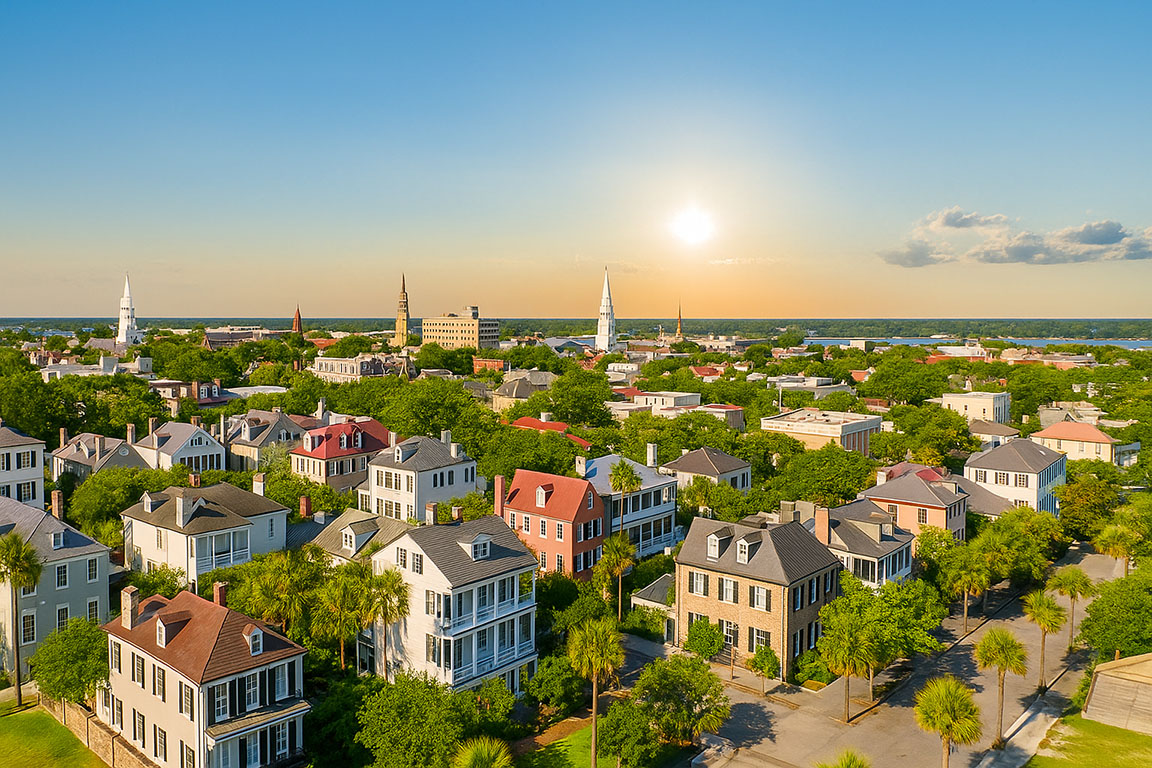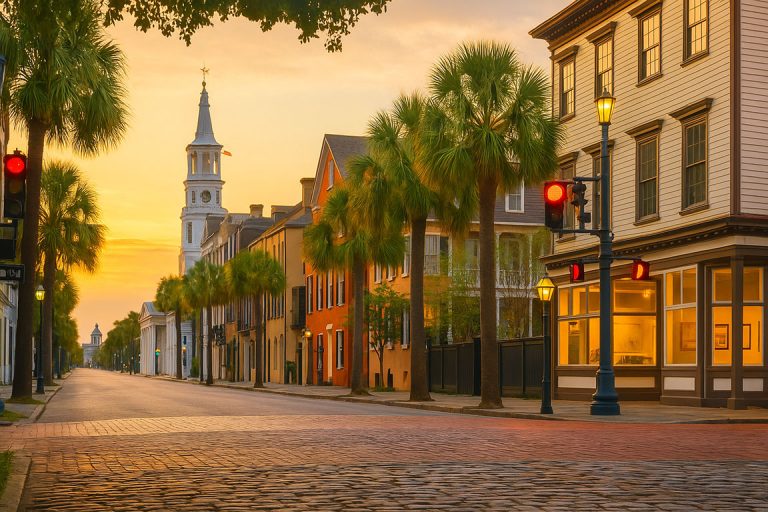Straddling the Cooper River just eight miles from downtown Charleston, Mount Pleasant feels more like a self-contained town than a Charleston suburb. The population in this Lowcountry town is near 68,000.
Residents fill Saturday mornings with farmers-market runs under the massive live oaks at Moultrie Middle, paddle hard into the Wando River’s breakfast-flat water, then claim a shrimp basket at Waters Edge before sunset.
Locals call it “Mayberry with marinas”—the vibe tilts laid-back, but you’re ten minutes from Charleston’s past-midnight jazz bars if cabin fever kicks in.
Cost of Living in Mount Pleasant, South Carolina
Mount Pleasant commands a premium. BestPlaces gives the town a cost-of-living score of 112—about 12 percent higher than the national average and 25 percent above the South Carolina norm, with housing the main culprit. Property-tax bills climb because assessed values keep rising, and flood-zone insurance tacks on four-figure extras for homes near marsh fingers.
Groceries hover close to U.S. medians thanks to Publix and Costco competition, and utility costs stay mild (natural-gas heat rarely clicks on). South Carolina’s state income-tax top bracket kicks in at $16,000, so higher earners should plan for a 6.5 percent bite, though the lack of local income taxes offsets part of the sting.
A couple with two kids can live comfortably on roughly $110K a year.
Median Home Prices
Realtor.com pinned April 2025 median listing prices at $967,000, while Zillow’s Home Value Index showed an average of $876,150—both up about three percent year-over-year. Redfin puts the median sold figure even higher at $900,000, with homes lingering only 52 days before going under contract. Old Village’s clapboard two-beds trade north of $1.2 million, but newer Carolina Park colonials list closer to $750K.
Across the harbor, I’On’s rainbow-row facades push $2.3–$2.6 million, a price fueled by deep-water docks and an HOA that staffs its own landscape crew. Townhomes and 1990s brick ranches west of U.S. 17 give first-time buyers their best shot, hovering in the high $500Ks.
The Pros of Living in Mount Pleasant
Excellent Public Schools
Schools in Mount Pleasant are highly rated. Charleston County School District funnels Mount Pleasant kids into campuses that top statewide leaderboards. Lucy Garrett Beckham High posts 93 percent reading proficiency and a 1240 average SAT, slotting it in the state’s top forty, while Wando High School fields one of South Carolina’s largest AP catalogs and a band program that routinely marches in the Macy’s parade.(niche.com)
Elementary schools and feeder middle schools—Laing, Cario, Moultrie—score similar A grades, making private-school tuition an optional splurge rather than a requirement.
Proximity to Beaches and Charleston
Weekdays can end with toes in sand. Isle of Palms and Sullivan’s Island bookend Mount Pleasant, each less than fifteen minutes from most neighborhoods in Mount Pleasant. A sunrise surf at Station 28.5 still leaves time to shower before the 9 a.m. Zoom.
Cross the Ravenel Bridge in the opposite direction and you’re in downtown Charleston in ten minutes without traffic—close enough to snag Husk reservations or watch the RiverDogs on a whim.
Vacation guests love that Charleston International Airport sits 22 miles away, usually under a half-hour door-to-gate unless I-526 clogs.
Outdoor & Family Friendly Scene
Marsh grass and water weave through daily life. Kayakers launch at Shem Creek’s floating docks, dodging dolphin pods that beg scraps from shrimp boats. Cyclists hammer the shaded Mount Pleasant Way trail before temperatures spike, while trail runners claim the 943-acre Laurel Hill County Park for six-mile loops beneath longleaf pines.
Weekends bring pickleball tournaments to the Park West Recreation Complex, stand-up paddleboard yoga under the Ravenel’s cables, and family picnics on the lawn at Memorial Waterfront Park where the USS Yorktown looms across the river.
Less Congestion Than Charleston
Yes, U.S. 17 backs up at the Long Point merge, but compare it to downtown Charleston’s one-way gridlock and you’ll gladly wait a few light cycles. Suburban roadways like Rifle Range and Hungryneck split north-south traffic, and most grocery runs finish without parallel-parking anxiety.
The Ravenel Bridge holds eight lanes, so even evening bottlenecks rarely exceed fifteen minutes, and Mount Pleasant’s own restaurant scene—Shem Creek oysters, Belle Hall ramen, Hibben’s homey pizza—lets residents skip peninsula treks on weeknights.
The Potential Cons of Living in Mount Pleasant
High Cost of Living
That BestPlaces score of 112 hides sharper spikes. Housing indexes at 148, and property-tax bills swell as county appraisers chase market values. Dinner for two at a waterfront restaurant easily tops $120 before tip, and child-care waitlists can cost a non-refundable $200 just to hold a crib spot.
Health-insurance premiums track national averages, but local service providers tilt out-of-network for some carriers, adding surprise co-pays. If your salary arrives from a Charleston-based employer rather than a remote tech gig, be ready for sticker shock.
Traffic
Growth outpaced roadwork for a decade, and the evidence shows every weekday at 3 p.m. when school pickup collides with construction trades leaving job sites.
U.S. 17’s pinch points at Boone Hall and Towne Centre still rely on stoplights instead of overpasses; one fender-bender can balloon a 12-minute drive into 40.
Summer beach traffic funnels through the Isle of Palms Connector like toothpaste in a straw, and rainstorms give the Ravenel Bridge a “no-towing until lightning clears” policy that strands thousands.
Car dependency is a fact of life—public buses exist but run hourly at best.
Potential Flood Risks
More than half of Mount Pleasant properties already carry some flood potential; projections push that to nearly 70 percent by 2055.(firststreet.org) FEMA zone-AE maps blanket Old Village and Brickyard Plantation, mandating elevation certificates for remodel permits and wind-rated doors that add thousands to budgets.
King-tide roads close about a dozen times a year, a statistic locals shrug off but newcomers learn quickly. The town funds drainage overhauls, yet heavy rain plus an astronomical tide can still trap minivans in ankle-deep saltwater on Coleman Boulevard.
Ready to Live in Mount Pleasant?
Balance sunlit paddleboard commutes against higher mortgage payments, and Mount Pleasant often wins the math as a great place to plant roots. You swap peninsula parking hunts for neighborhood oyster roasts, trade big-city sirens for cicada-loud evenings, and still catch downtown Charleston’s culinary fireworks whenever the craving strikes.
Mount Pleasant offers plenty of top-notch schools, river-skimming breezes, and a community that waves from porch swings rather than apartment balconies. These reasons make Mt. Pleasant one of the best places to live in South Carolina. Looking to move?
FAQs About Living in Mount Pleasant, SC
Is Mount Pleasant affordable for first-time buyers?
Entry-level options exist—think 1980s ranches off U.S. 17 or two-bed townhomes in Hamlin—but anything under $600K sparks bidding wars. Many buyers rent for a year to learn neighborhoods and save a bigger down payment.
How long is the commute to downtown Charleston?
Without traffic, you’ll clear the Ravenel in ten minutes. Add school dismissal or a summer Saturday bridge backup, and the drive stretches to 30–35 minutes. Bright side: free parking after 6 p.m. downtown eases sticker shock.
Do you need flood insurance?
Mortgage lenders require policies in FEMA zones, and many cash buyers purchase coverage voluntarily. Premiums range from $900 on elevated new builds to $4,000-plus for slab-on-grade cottages in Old Village.
What industries hire locally?
Healthcare (Roper St. Francis, MUSC satellite clinics), military contractors, port logistics, and a growing remote-tech cohort top the list. Many residents commute across the bridge to finance or hospitality gigs in Charleston, leveraging Mount Pleasant’s quieter evenings for work-life balance.






